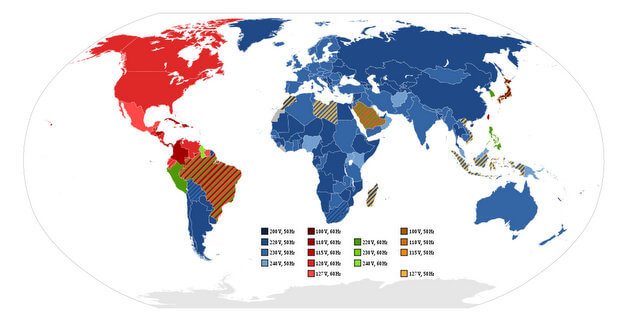Logistics are difficult when traveling, especially if you use a powered wheelchair. Planning, for electric wheelchair users like me, goes beyond finding accessible hotels, restaurants, and attractions – I need to consider when and how I’m going to charge my wheelchair as well!
This might not seem like a daunting task, since you’re probably planning to go somewhere with electricity and electric outlets, so you should be all set — right? Not so fast. If you’re traveling abroad, it’s not quite that simple.
Here’s a guide to mastering the logistics behind charging your powered wheelchair while abroad:

Step 1: Check the Voltage for Your Destination
Those who are traveling abroad for the first time are often surprised to find out that electric appliances – hairdryers, electric razors, and yes, electric wheelchairs – are often different in each country. Why is this? Well, they have to be different, because the main electricity voltage in each country is different!
While voltage used in each country is decided nationally, it’s convenient that the same voltage tends to be used regionally. For example, all of Europe, most of Asia, Australia, Chile and Argentina, and most of Africa use 220-240 V at a frequency of 50 hertz. All of North America and about half of South America use 110-127V at 60 hertz; Peru, the Koreas, the Philippines, and a few other countries use 220-240V at 60 hertz; and parts of Japan and Madagascar use 110-127V at 50 hertz.

Don’t worry if these numbers don’t mean anything to you, because they don’t have to! It’s not necessary to understand the physics behind the world’s convoluted electrical grid – all you need to know is the voltage and frequency (measured in hertz) associated with the countries you’re going to. But how do you find out which numbers apply to which countries?
You can see the regional trends I described on the simple, color-coded map above. So, Step 1 is to find your destination on the map to see which voltage and hertz they use. You’ll need this information to buy a voltage converter later, so that you can use your appliances while there.
Step 2: Check the Plugs and Socket Types for Your Destination
But before you buy a voltage converter, there’s one more thing to consider – plug or socket type. Knowing the voltage used in the country you’re headed to isn’t quite enough, because it turns out that each country uses a different plug type as well! Some have mainly two-pronged outlets; others have three. Some have sockets with the two vertical slits, like we have in the United States, and others have sockets with round holes. Some places even have a mix of these two, and there are even more different styles.
Unfortunately, the countries with the same voltages don’t necessarily use the same plug types. For example, though they use the same voltage and frequency, Italy and the UK have different plug types than the rest of Europe. China and India have different plug types than the rest of Asia, whom they share the same voltage with, and there are many similar examples.
When all is said and done, there are a surprising 15 types of outlets and plugs. This list contains the voltages, hertz, and plug types for every country in the world, and a color-coded world map showing solely the plug types of each country can be found here. To make sure you have the right plug type as stated on the list, you can see pictures of the 15 different styles here.
So, Step 2 is to check the plug types of each country you’re going to, and make a list of all the different types you’ll need. Luckily, you won’t need to buy whole new chargers for your appliances – you’ll just need an attachment to put on the end of your plug that allows you to put it in a different type of socket.
Step 3: Buy the Tools You Need to Use Your Electric Appliances
Now that you know the voltage, frequency, and plug type for each of the countries on your itinerary, you’re ready to buy the items you need in order to be able to use your wheelchair (and hairdryer, etc). But first, let me define two common tools you’ve probably heard of before and explain the differences between them.
Adapters vs. Converters
Adapters do not convert electricity from one voltage to another; they simply allow your appliance, which has one plug type, to fit into a socket of a different type. If you travel to a country with the same voltage as yours, but they use a different plug type, adapters are all that you need. For example, since the United States and most of Brazil use 110-127V, you don’t need to buy an electricity converter when going between these countries – all you need is an adapter, since they have different plug styles.

This is what adapters look like typically.
However, if you are traveling to a place with a different voltage, you’ll need what is called a converter, which does convert electricity from one voltage to another. If the place you’re traveling to has a different voltage and different plug types, you can buy something that is both an adapter and a converter.
It’s important to note that converters work hard and should always be unplugged when they’re not in use. In fact, they really aren’t designed for more than a couple hours’ use at a time, so sometimes they might not work too well to charge your wheelchair. I know this firsthand because of an experience I had in Germany eight years ago: All we did was plug my wheelchair battery charger into our hotel room’s outlet (using the proper adapter and converter) – but it blew up! Sparks were literally flying, and it even caused the hotel’s power to go out for about 15 minutes.

This photo was taken just a couple hours before the outage
Luckily, we were able to find a wheelchair repair shop right in Munich after some online searching, and the hotel never did figure out that we caused the power outage! At the repair shop, I ended up buying a 240 Volt charger, so that I could charge my wheelchair in Europe without using a converter. It set me back about 250 Euros, but since so many other countries use 220-240V electricity, I’ve been able to use it a lot of times since then and it has ended up being a good investment.
If you’re planning on traveling more in the future and want to avoid dealing with finicky and moody converters, it might be a good idea just to buy a 240 Volt charger for your wheelchair right off the bat. Another option is to buy a transformer, which has the same function as a converter, but it’s much more powerful and can be used for longer periods of time. You can find transformers and 240V chargers on Ebay and Amazon, and battery chargers on MobilitySmart.
Step 4: Look Up Wheelchair Repair Shops in the Area
If you do your research ahead of time and buy all the necessary converters, transformers, chargers and adapters, you shouldn’t have any problems. However, as you can see from my anecdote above, unforeseen issues do sometimes arise. In cases like this, it’s good to have a plan. It can be difficult to find wheelchair repair shops abroad, especially if you don’t speak the language – so noting the location of these shops beforehand is indispensable.
Have you ever had an electricity-related incident abroad? I’d love to hear about it in the comments!








We are in your same situation right now in Portugal. We blew up the wheelchair battery charger even though the converter was working properly. We are now going to rent a 240 volt battery charger, but are concerned that putting a 240 volt charger on a chair for 110 voltage is a bad idea. We DO NOT want to blow up the chair as you can imagine. Can you shed some light on this? How can you put a 240 volt charger on a chair that is set at 110 volt? ANY insight you have would be timely and greatly appreciated.